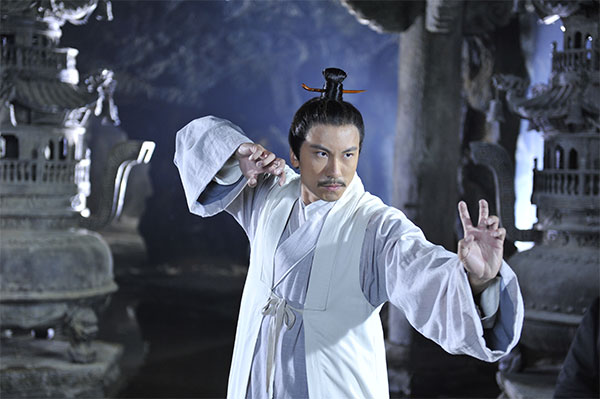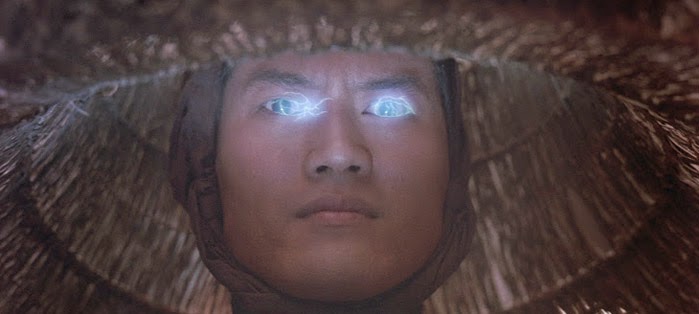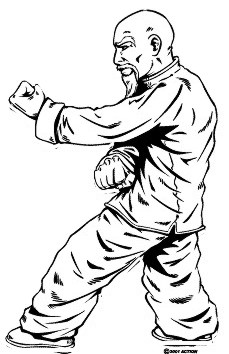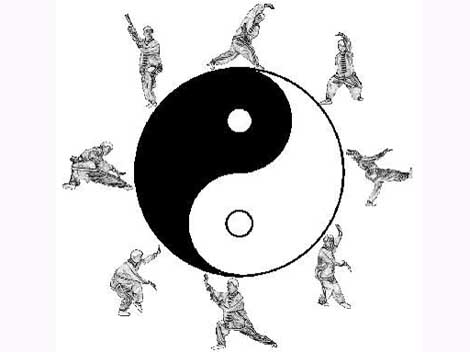The World of Kung-Fu 3.3: Wudang
Wudang Priests: The Mystical Alchemists
Q: “How do you get to Wudang Mountain?”
A: “Practice!”—Wudang riddle.
The Wudang priests claim that they invented Kung Fu. Given their near-mythic reputation as fighters, it isn’t that hard to believe. From time immemorial, the Daoist priests of Wudang Mountain have meditated and speculated, studied and practiced. Masters of alchemy and other strange magics, there are few wondrous abilities that haven’t been attributed to the Wudang in some story or other.
Wudang Mountain itself is hidden by magic and can only be found by those worthy to find it. It would appear to have no fixed geographical location. Through the centuries, it has attracted seekers after enlightenment. Some search for the mountain their whole life and never find it, while others arrive at the mountain at the end of a mystical vision-quest, or simply stumble across it. Sometimes people fleeing from danger, or otherwise in need of sanctuary and protection, accidentally find their way to the mountain, where the priests take them in and train them in the Kung Fu they will need to defend themselves. Likewise, sometimes a noble soul who has been defending the defenseless will stumble across Wudang and be taught Kung Fu.1
Anyone who finds Wudang Mountian once is able to find their way back there.
“How do you get to Wudang Mountain?”
“It’s easy if you know the way”—Wudang riddle.
The Wudang deny that their own nature and importance can be expressed in words. Their texts are so cryptic as to be unintelligible to outsiders. Their ultimate goal seems to be personal. More specifically, they strive to alter their state of existence and become “one with the Dao” through meditation and many other means, including Kung Fu. They teach that their way is not the only way to achieve this altered state. Everyone must find their own path. Most Wudang spend their entire lives on the mountain, but some leave to fight the Kung Fu War, and even more leave just on a whim, following their impulses wherever they lead.
Common Professions: Beggar, fortune teller, traditional healer.
Wudang Kung Fu 6 points.
Skills: Alchemy, Judo, Karate, Philosophy (Daoism), Sword.
Techniques: Any Judo, Any Sword, Feint (Judo or Karate), Back Kick, Jump Kick, Spinning Kick, Spinning Punch, Springing Attack, Sweep (Judo or Karate).
Cinematic Skills: Blindfighting, Body Control, Flying Leap, Hypnotic Hands, Immoveable Stance, Light Walk, Lizard Climb, Mental Strength, Pressure Points, Pressure Secrets, Push, Sensitivity.
Cinematic Tequniques: Any Judo, Any Sword, Flying Jump Kick, Pressure Point Strike, Roll with Blow, Timed Defense.
Perks: Chi Resistance: Any, Drunken Fighting, Special Exercises (DR 1 with Tough Skin), Special Exercises (Striking ST +1), Style Adaptation (Any Chinese Style), Technique Mastery (Any Judo or Sword).
Wudang Magic
Wudang are often magicians, and might potentially have any power or spell that the GM does not think would unbalance the campaign. The GM should use any magic system they prefer for Wudang magic, though the system in GURPS Thaumatology: Chinese Elemental Powers would be particularly flavorful.
Wudang Relations
Shaolin: The Wudang understand that the Shaolin are essentially compassionate and fight for what is right, but they find them smug, judgmental, bossy, preachy, and generally annoying. The Shaolin are always telling other people how to live, but don’t really listen to what other people have to say.2
Q: “What do you call a Shaolin alchemist?”
A: “Trippy Taka”—Wudang riddle.
Wing Chun: Wudang can’t help liking Wing Chun, despite their Shaolin roots. Wing Chun has fought the Kung Fu War relentlessly and effectively. Again and again, Wing Chun has organized the Kung Fu resistance while other factions bickered. Wudang finds Wing Chun honorable, courageous, and deeply committed to doing the right thing. It doesn’t hurt that Wing Chun goes out of its way to show respect to Wudang, and to treat the priests with traditional reverence.
Vigilantes: The Wudang are wary of the Vigilantes. In the best of them, the Wudang see modern versions of the Chinese peasant heroes of old.3 Unlike the Shaolin, the Wudang aren’t bothered by the Vigilantes’ anarchic and western ways. On the other hand, they know that Vigilantes are much more likely than Wulin to cross moral lines and turn into monsters, killing their enemies and engaging in other atrocities.
Allies of Wudang
Hsing I Chuan
“The true Dao cannot be expressed, but good Kung Fu is always respected”—Yue Fei, Song Dynasty, 1120.
Hsing I Chuan is a military style developed by General Yue Fei of the Song Dynasty (960-1127), intended to be used by officers to overthrow the evil emperor Gaozong. Ever since, the style has been the basis of a secret cabal in the Chinese military, with Hsing I Chuan masters training fellow officers they deem righteous and worthy. The style spread as Chinese people emigrated, and Hsing I Chuan is now firmly entrenched in the military forces of the US and other nations.
Many in the Wudang faction frown on Hsing I Chuan’s military bent, especially the peaceful Pa Kua Chuan. Hsing I Chuan regards these criticisms as impractical. They reason that soldiers often have an important job to do protecting people, and should use every honorable tool to get the job done.
Hsing I Chaun have a traditional rivalry with Pa Kua Chuan over which of them is most righteous, and which has the best Kung Fu. Hsing I Chuan fighters often study the non-cinematic skills and techniques of Pa Kua Chuan to learn how to counter them. The rivalry dates back to sometime around the end of the Manchu Dynasty (1644-1917) and a tournament held between Hsing I Chuan master Kuo Yun-shen, known as “Half-Step Gao”, and Pa Kua Chan master Tung Hai-Ch'uan, known as “Turning Palms Tung”. According to legend, the two fought for three days straight but neither was able to overcome the other, until finally they parted “in mutual embarrassment, their faces red like the Lotus.” Worse yet, later accounts of the fight appeared that said Tung won, infuriating Hsing I Chuan, who accused Pa Kua Chan of being behind the false stories.
Hsing I Chuan also has a rivalry with Shaolin faction Praying Mantis, since both use the military and special forces as a recruiting ground.
Hsing I Chuan masters are very selective when taking on students. They will rarely be willing to pass their skills on for money, but concern themselves instead with the student’s moral character and potential to contribute to the Kung Fu War. A suitable candidate will likely already be bravely and honorably fighting evil.
Common professions: Hobo, military officer, government worker who used to be military officer.
Pa Kua Chuan
“Read the I Ching. I have nothing more to say.”—Emperor Fu Xi, Shang Dynasty, 1123 BC.
Pa Kua Chuan was developed in the 14th century by a circle of Daoist priests on Wudang mountain, who wanted to spread Daoism and help ordinary people reach enlightenment. Pa Kua Chuan is primarily an aid to meditation and a means of developing chi, and only happens to be devastating Kung Fu as a side effect. Today, Pa Kua Chuan masters still see their art as primarily a means to self-development, though they also recognize the need to support the Kung Fu War.
In America, Pa Kua Chuan has a long history of Daoist evangelization, but like the Shaolin, they have had very little success spreading their religion, let alone converting the entire country as they hope. However, Pa Kua Chuan are nothing if not patient.
As noted under Hsing I Chuan, the two styles have been rivals since the Manchu Dynasty. Pa Kua Chuan thinks that Hsing I Chuan has given up true Daoist values and become tools of the state. Hsing I Chuan think that Pa Kua Chuan has become pompous and useless, lost in their own self-regard.
Genuine Pa Kua Chuan training is hard to find, let along training by a master. True masters tend to be secretive about their skills, and rarely seek students or teach classes for money. However, they may be persuaded to take on a student if they seem particularly worthy, particularly in need of good Kung Fu, and/or particularly sincere in their Daoism.
Common Professions: Fortune teller, herbalist, hermit, hobo, Daoist priest, traditional healer, unskilled and semi-skilled labor.
Tai Chi Chuan
“Healthy body. Healthy mind. Breathing…breathing…breathing….”—Shang Sanfeng, Tai Chi master, Song Dynasty, 12th century.
Tai Chi has become by far the most popular martial art descended from Wudang Kung Fu. The style was developed in the 12th century by Daoist priest Zhang Sanfeng, who wanted to provide the peasants with Kung Fu to defend themselves from bandits with, and a regimen of exercise to improve their health. Zhang left Wudang Mountain and wandered China, teaching Kung Fu and medicine for free.
Learning to fight well with Tai Chi is an arduous process. On the other hand, the health benefits are quickly apparent and don’t require strenuous exercise. This has lead Tai Chi to become more popular as a aid to good health than as a fighting form, despite how devastatingly effective it can be in battle. Today, most Tai Chi masters no longer seek to spread fighting arts, but remain committed to propagating Tai Chi for health.
Tai Chi’s popularity with the American public makes it the most easily recognized and most reputable of the Wudang faction styles. This can be handy when the faction needs a public face. On the other hand, many in the Wudang faction fear that Tai Chi is spreading potentially dangerous skills, and have been as irresponsible in taking on students as Karate and Taekwondo have. Unlike other Wudang faction styles, Tai Chi Chuan goes out of its way to be respectful to the Shaolin. They make no secret of the fact that they would like the see the Shaolin/Wudang rivalry put to rest.
Tai Chi actively recruits through its many classes. Insofar as the Wudang faction can field “troops”, they will mostly be Tai Chi students. Students of particular ability and moral soundness are chosen for special training if they swear to serve Tai Chi forever.
Common professions: Doctor, martial arts instructor, nurse, nutritionist, paramedic, personal trainer, teacher, traditional healer.
Wudang as Villains
The classic fallen Wudang is an insane sorcerer. Wudang are most often corrupted through the desire for power and knowledge, especially magical power and esoteric knowledge. The Laughing Devils were Wudang before the sect were tempted by demons, and they have not been the last Wudang to fall to demonic temptation. Some Wudang become the minions of powerful spirits or ancient monsters. Many are actively evil while others just become so focused on their studies and experiments that they stop caring about people.
On the rare occasions that Hsing I Chuan or Pa Kua Chuan fighters go bad, they can make easy money as mercenaries. Hsing I Chuan masters often have military contacts, and make very valuable paramilitary forces. Tai Chi Chuan fighters who go bad most often go bad in entire schools, as a corrupt teacher leads his students into a life of crime.
Footnotes
1. As recorded in the 19th century poem “Heaven Oddity”, in which the ex-military officer Tsu Tang (Daoist name, Zenghi “Stardust”), expresses his rejection of Wushu government.
“This is Major Tang to world control. / I fought your stupid wars.
And you took my joy and righteousness away. / But things look very different today.
‘Cause I’ve been chilling with the Wudang / Far above the world.
Now you’re feeling blue / ‘Cause you can’t beat my Kung Fu!”
2. Rivalry towards the Shaolin is not limited to the Wudang faction and is particularly likely to be found in internal styles. Consider the anonymous 13th century internalist poem, “Grab and Roll Kung Fu”.
Give me that grab and roll Kung Fu. / That’s the way to beat Wushu.
Throw me while I throw you. / Upside-down’s a great view.
It’s got to be grab and roll Kung Fu / If you want to fight with me.
I got nothin’ ‘gainst external styles / If you want to lose awhile.
You can punch like the Shaolin do. / But man, that is foo-foo Fu. (Oo!)
Its got to be grab and roll Kung Fu / If you want to fight with me.
3. China has always had vigilante activity of its own, particularly in response to crime. Consider Zi Qi’s 19th century poem, “Chin Na Girl”.
Oh ho ho ho, little Chin Na girl.
I could stop those gangsters / With my Chin Na girl.
I’d walk right up and tell them / With my Chin Na girl.
I’d be like, “Do you want to dance, motherfuckers?
‘Cause we’re here and we’re ready to throw down.
We’ll give you sixty seconds. / Then we’ll break out our Kung Fu.
I’m average but there’s no way you can beat my girl.
Don’t make her use python-strike!
She says, “Yaaaa!”, She says, “Yaaa!”




